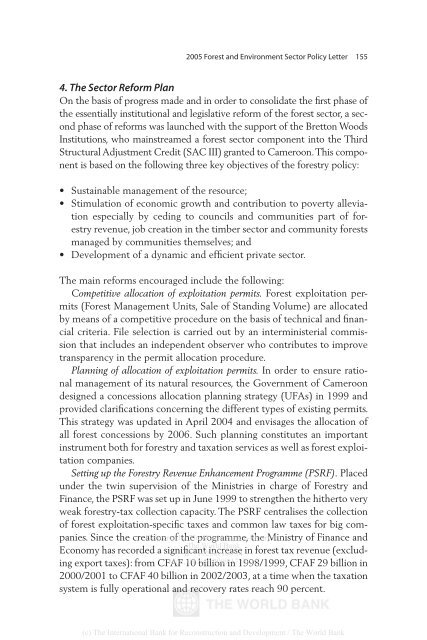The Rainforests of Cameroon - PROFOR
The Rainforests of Cameroon - PROFOR
The Rainforests of Cameroon - PROFOR
- No tags were found...
Create successful ePaper yourself
Turn your PDF publications into a flip-book with our unique Google optimized e-Paper software.
2005 Forest and Environment Sector Policy Letter 1554. <strong>The</strong> Sector Reform PlanOn the basis <strong>of</strong> progress made and in order to consolidate the first phase <strong>of</strong>the essentially institutional and legislative reform <strong>of</strong> the forest sector, a secondphase <strong>of</strong> reforms was launched with the support <strong>of</strong> the Bretton WoodsInstitutions, who mainstreamed a forest sector component into the ThirdStructural Adjustment Credit (SAC III) granted to <strong>Cameroon</strong>. This componentis based on the following three key objectives <strong>of</strong> the forestry policy:• Sustainable management <strong>of</strong> the resource;• Stimulation <strong>of</strong> economic growth and contribution to poverty alleviationespecially by ceding to councils and communities part <strong>of</strong> forestryrevenue, job creation in the timber sector and community forestsmanaged by communities themselves; and• Development <strong>of</strong> a dynamic and efficient private sector.<strong>The</strong> main reforms encouraged include the following:Competitive allocation <strong>of</strong> exploitation permits. Forest exploitation permits(Forest Management Units, Sale <strong>of</strong> Standing Volume) are allocatedby means <strong>of</strong> a competitive procedure on the basis <strong>of</strong> technical and financialcriteria. File selection is carried out by an interministerial commissionthat includes an independent observer who contributes to improvetransparency in the permit allocation procedure.Planning <strong>of</strong> allocation <strong>of</strong> exploitation permits. In order to ensure rationalmanagement <strong>of</strong> its natural resources, the Government <strong>of</strong> <strong>Cameroon</strong>designed a concessions allocation planning strategy (UFAs) in 1999 andprovided clarifications concerning the different types <strong>of</strong> existing permits.This strategy was updated in April 2004 and envisages the allocation <strong>of</strong>all forest concessions by 2006. Such planning constitutes an importantinstrument both for forestry and taxation services as well as forest exploitationcompanies.Setting up the Forestry Revenue Enhancement Programme (PSRF). Placedunder the twin supervision <strong>of</strong> the Ministries in charge <strong>of</strong> Forestry andFinance, the PSRF was set up in June 1999 to strengthen the hitherto veryweak forestry-tax collection capacity. <strong>The</strong> PSRF centralises the collection<strong>of</strong> forest exploitation-specific taxes and common law taxes for big companies.Since the creation Delivered <strong>of</strong> by the <strong>The</strong> programme, World Bank e-library the Ministry to: <strong>of</strong> Finance and<strong>The</strong> World BankEconomy has recorded a significant IP : 192.86.100.34 increase in forest tax revenue (excludingexport taxes): from CFAF Mon, 10 09 Nov billion 2009 in 17:06:18 1998/1999, CFAF 29 billion in2000/2001 to CFAF 40 billion in 2002/2003, at a time when the taxationsystem is fully operational and recovery rates reach 90 percent.(c) <strong>The</strong> International Bank for Reconstruction and Development / <strong>The</strong> World Bank
















